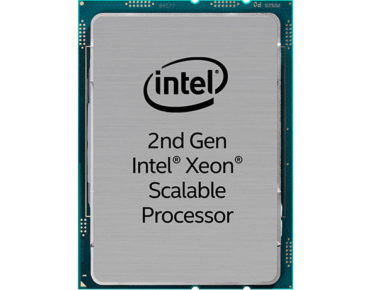Intel Updates 2nd Gen Xeon Scalable Chips and 5G Network Portfolio Products

Intel this morning announced an 18-SKU update to its second-generation Xeon Scalable chip lineup for data center workloads, stating that the refreshed Gold processor delivers an average of 1.36-times higher performance and 1.42-times better performance-per-dollar compared with the first generation of the chip (i.e., the first-gen Cascade Lakes).
The company said the processors — labeled with an “R” (refresh), “T” (higher temperature tolerance), or “U” (single socket) suffix — are designed for dual- and single-socket mainstream and entry-level server systems. At the high end, the Xeon Gold product line tops out at 28 cores, clock speed of 4.5 GHz with “turbo boost,” cache of 38.5MB (a 33 percent increase), peak power consumption of 205W, support for Intel Optane persistent memory and a price range of between $3,950 and $1,273, for the low-end version (see table below).
The company also announced higher performance for Xeon Silver and Bronze mid- and entry-level server chips.
“The addition of more cores and increased cache in these processors are targeted at workloads where capacity-per-server is critical, such as virtualized clouds, hyper-converged infrastructure (HCI) and network function virtualization (NFV),” the company said in a blog.
Several server OEMs, including Dell EMC, Nor-Tech, Supermicro, GIGABYTE and TYAN, announced support for the updated Xeons.
Intel today also announced a new Atom P5900 10nm SoC designed for wireless base stations in 5G network deployments. Along with the 2nd-gen Xeons, it’s part of a larger portfolio of new 5G network infrastructure products that includes a structured ASIC, code name “Diamond Mesa,” FPGA accelerator, a 5G network-optimized Ethernet NIC and new software capabilities integrated into Intel’s Open Network Edge Services Software (OpenNESS), which the company said eases deployment of cloud-native edge microservices in support of custom 5G implementations.
“As the industry makes the transition to 5G, we continue to see network infrastructure as the most significant opportunity, representing a $25 billion silicon opportunity by 2023,” said Navin Shenoy, EVP/GM of Intel’s Data Platforms Group. “By offering customers the fastest and most effective path to design, deliver and deploy 5G solutions across core, edge and access, we are poised to expand our leading silicon position in this growing market.”













